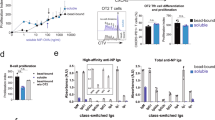Abstract
CELL mediated immune reactions in mice involving cytotoxic thymus derived lymphocytes have two important features; they are antigen-specific1 and the structures coded for by the major murine histocompatibility gene complex (H–2) play an important part in killer cell-target cell interaction1. This finding is not unique to mice since it has also been reported for rats, humans and chickens2–4. Two hypotheses have been suggested to explain this dual specificity of T killer cells; one proposes that T killer cells possess two separate structures, one of which recognises self H–2 structures and the other a non-H–2 antigen (dual recognition). The other hypothesis proposes that T killer cells possess one receptor which recognises an H–2 antigen modified by a non-H–2 antigen (modified self)1,5. Evidence to test these hypotheses was sought by preparing chimaeras made by reconstituting lethally irradiated F1 mice with bone marrow stem cells of one parent (Parent→F) refs 6–8) or neonatally tolerant mice9 (mice of a parental H–2 type injected with F1 cells as neonates). As a result, Parent → F1 chimaeric lymphocytes lysed infected and trinitrophenyl (TNP)-modified targets of both parental H–2 types, suggesting that H–2 antigens of the killer cells were not involved in the lytic interaction. In contrast, lymphocytes from neonatally tolerant mice did not lyse infected targets from the incompatible parent9. Although these results can be explained by postulating a single receptor, they also fit the dual recognition hypothesis6–10. Bevan has shown that irradiated bone marrow chimaeras of the type (A × B)F1 → Parental A recipient generated preferentially cytotoxic T cells against minor histocompatibility antigens in association with the H–2 haplotype of the recipient A; he concluded that the chimaeric host determines the specificity of T cell restriction either through a thymic selection process as proposed by Jerne or alternatively through an antigen presentation mechanism.
This is a preview of subscription content, access via your institution
Access options
Subscribe to this journal
Receive 51 print issues and online access
$199.00 per year
only $3.90 per issue
Buy this article
- Purchase on Springer Link
- Instant access to full article PDF
Prices may be subject to local taxes which are calculated during checkout
Similar content being viewed by others
References
Transplant. Rev. 29 (1976).
Wainberg, M. A., Markson, Y., Weiss, D. W. & Doljanski, F. Proc. natn. Acad. Sci. U.S.A. 71, 3565–3570 (1974).
Zinkernagel, R. M., Althage, A. & Jensen, F. C. J. Immun. 119, 1242–1247 (1977).
Goulmy, E., Termijtelen, A., Bradley, B. A. & Van Rood, J. J. Nature 266, 544–546 (1976).
Zinkernagel, R. M. & Doherty, P. C. Nature 251, 547–548 (1974).
Pfizenmaier, K., Starzinski-Powitz, A., Rodt, H., Rollinghoff, M. & Wagner, H. J. exp. Med. 143, 999–1005 (1976).
Von Boehmer, H. & Haas, W. Nature 261, 141–143 (1976).
Zinkernagel, R. M. J. exp. Med. 144, 933–945 (1976).
Zinkernagel, R. M., Callahan, G. N., Streilein, J. W. & Klein, J. Nature 266, 837–839 (1977).
Katz, D. H. & Benacerraf, B. The Role of Products of the Histocompatibility Gene Complex in Immune Responses, 355 (Academic, New York, 1976).
Bevan, M. J. Nature 269, 417–419 (1977).
Dennert, G. & Hatlen, L. E. J. Immun. 114, 1705–1712 (1975).
Schmitt-Verhulst, A. M. & Shearer, G. M. J. supramolec. Struct. Suppl. 1, 206 (1977).
Wilson, D. B., Lindahl, D. F., Wilson, D. H. & Sprent, J. J. exp. Med. 146, 361–367 (1977).
Jerne, N. K. Eur. J. Immun. 1, 1–9 (1971).
Zinkernagel, R. M. et al. J. exp. Med. (in the press).
Author information
Authors and Affiliations
Rights and permissions
About this article
Cite this article
ZINKERNAGEL, R., CALLAHAN, G., KLEIN, J. et al. Cytotoxic T cells learn specificity for self H–2 during differentiation in the thymus. Nature 271, 251–253 (1978). https://doi.org/10.1038/271251a0
Received:
Accepted:
Published:
Issue Date:
DOI: https://doi.org/10.1038/271251a0
This article is cited by
-
A Phase II Study of Partial and Subtotal Thymectomy for Thymoma (JART02)
World Journal of Surgery (2017)
-
The transcriptional landscape of αβ T cell differentiation
Nature Immunology (2013)
-
Immunological tolerance 50 years after the Burnet Nobel Prize
Immunology & Cell Biology (2011)
-
Genetic and proteomic analysis of the MHC class I repertoire from four ovine haplotypes
Immunogenetics (2008)
-
The discovery of agammaglobulinaemia in 1952
European Journal of Pediatrics (2003)
Comments
By submitting a comment you agree to abide by our Terms and Community Guidelines. If you find something abusive or that does not comply with our terms or guidelines please flag it as inappropriate.



